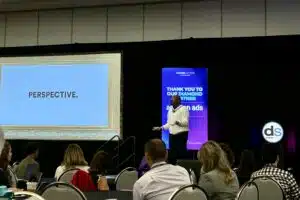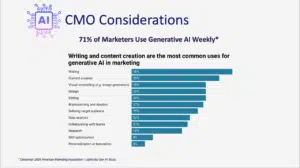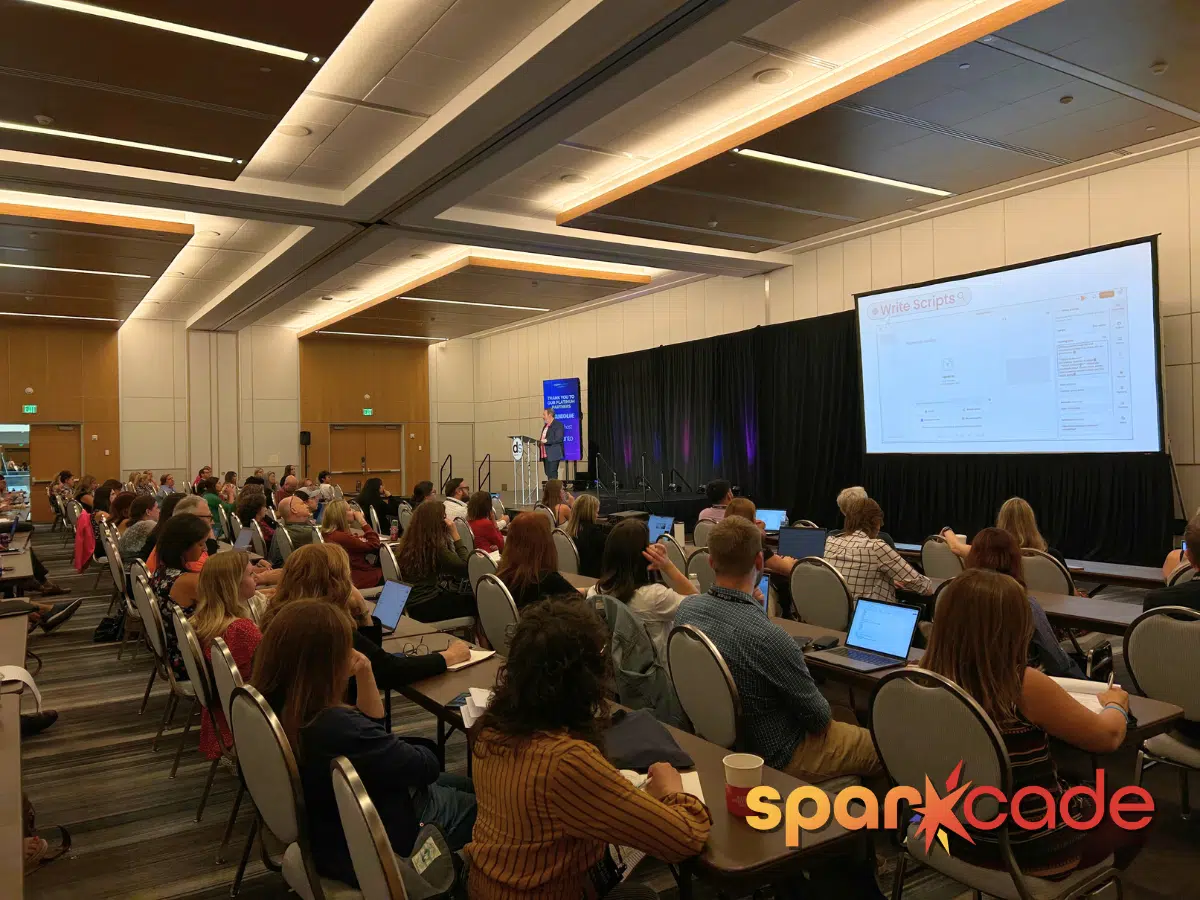Introduction: Why This Digital Marketing Conference Was on My Radar
As a fresh college grad, the opportunity to attend a conference was always on my professional bucket list. So, when I was invited to attend Digital Summit Minneapolis 2025 on August 6-7 at the Minneapolis Convention Center, the easy answer was of course.

It made me look like a twelve-year-old.
Digital Summit is one of the premier digital marketing conferences in the United States. Going in, I wanted more than just high-level marketing trends and professional development. I was looking for practical frameworks and real time networking with professionals who are genuinely moving the industry forward.
In this recap, I’ll share both my personal experience as an attendee and an overview of the conference’s standout speakers, sessions, and key takeaways.
On our first night in Minneapolis, we attended a happy hour hosted by Amazon Ads. During this fireside chat, they delved into hyper local advertising through Amazon Prime Video. With cocktails inspired by their array of shows, and an AI-generated portrait of me in the “Lord of the Rings” universe, I was invigorated and ready for the first day.
Setting the Stage: Venue & Atmosphere
Walking into the Minneapolis Convention Center on the first morning, the energy was undeniable. From agency pros and MarTech specialists to content creators and brand managers, marketers from every corner of the industry were ready to swap ideas and get inspired. The layout was smooth: spacious keynote hall, well-timed breakout rooms, and networking spaces that didn’t feel like an afterthought.
Opening Keynote: Marcus Collins

Attendees of Digital Summit received a complimentary copy of Marcus’s book, “For the Culture: The Power Behind What We Buy, What We Do, and Who We Want to Be.“
The conference kicked off with Marcus Collins, whose keynote “A Whole New World: Unlocking a Contemporary Perspective on Customer Centricity” set the tone. And if I wasn’t already excited, Marcus’s high energy and real-world case studies captivated the space as we heard about keeping the customer at the top of mind, through targeted ads and even in-store experiences.
KYC to ROI: The No-Fluff Guide to Audience Insight for Revenue Generation
During my first session, I scribbled notes about Paxton Gray’s focus on deep audience understanding, or knowing your consumer (KYC), as the foundation for ROI. He drove home that marketers need a balanced portfolio:
- 60% “bread and butter” content (proven winners)
- 25% “green shoots” (emerging channels)
- 15% “moonshots” (high-risk/high-reward bets)
Hearing him break it down live made me think about our own content mix—and where we may have been too safe or too risky.
Hack Your MarTech Stack: Master Efficient Content Marketing with Innovative Tools and Simplified Workflows
After a short break to network, it was back to the sessions particularly with Ariana Keil to hear all about auditing and streamlining your MarTech stack.
Her framework walked attendees through the steps to create more content, faster and with fewer resources:
- Conducting a MarTech audit
- Identifying integration gaps and redundancies
- Scoring tools based on metrics like “Does this save us time?”
- Engaging your team in the optimization process
- Planning for ongoing improvement
As an attendee, I loved how actionable this was. She connected broad view strategy with tangible workflow steps: Plan → Create → Collaborate → Organize → Publish → Analyze. From automated content scheduling to ROI dashboards, AI tools were woven into every stage.
Integrating Streaming TV into Your Marketing Mix (Hint: Easier than Expected)
Lendon Ebbins from Amazon Ads brought a fresh angle on streaming TV advertising, and this session was packed.
She emphasized the “living room advantage” which harbored intentional viewing, a premium distraction-reduced environment, and enhanced audience engagement.
She also shared a six-point readiness checklist for brands entering the streaming TV landscape:
- Define your goals and what your strategy will be.
- Who’s your target audience?
- Do you have enough creative assets to produce?
- What is your budget?
- How will you measure success and engagement?
- Will you be ready to launch your plan on schedule?
She would go on to emphasize the importance of expanding the conversion rate of aware consumers into dedicated advocates. Hearing case studies and data made me realize just how much untapped opportunity exists here.
Crack the Local Code: Axios Playbook to Driving Growth in High-Intent Markets
In this session, I heard from Kat Schaeffer and Melanie Spina from Axios Creative House. They spoke on how to target ideal customers where they are, without sounding like a company that just wants to sell you something. They offered multiple strategies on finding your target market:
- Talk like a local
- Lead with impact
- Show why it matters
- Make it scannable and sticky
- Say it smart
Consumers resonate with brands that speak in their language. You may be asking yourself, “How do I know where to find this information?” Thankfully, Schaeffer and Spina outlined four opportunities to gain insight on the local code:
- Ad campaign surveys
- Consumer studies
- Event insights
- Website Analytics
Survey Says: Rewriting Marketing Rules in a Chaotic Economic Climate
It’s no secret that the economic climate is unsteady right now. Ryan Huschka’s session was insight-first information into the atmosphere our consumers are living in currently. His research confirmed what many of us feel: when consumers feel squeezed, they shift to lower-priced alternatives that still meet core needs. This is also known as “value migration.”
He tied these shifts to historic ad spend patterns—like the 31% drop in 2008, including a 27% plunge for newspapers—and argued for:
- Leaning on first-party data
- Avoiding “stop and start” marketing spend
- Embracing advanced targeting, attribution, and new tech even in downturns
It was a sobering but empowering message: pull back at your own peril.
Purpose in Practice: Cause Marketing Strategies Driving Brand Trust and Loyalty
Jon Christensen’s talk with Molly Doyle and Jen Hellman on purpose-driven marketing had some of the most memorable Minnesota-local stats of the summit:
- 90% of consumers make purchase decisions based on corporate social responsibility (CSR)
- 75% of those under 40 rank CSR among their top three buying factors
In person, this felt like a wake-up call. He emphasized that consistency is what makes brand trust stick. Further, purpose can’t be a seasonal campaign, it has to be baked into operations.
Mastering Human-First Leadership in an AI-Driven Marketing World
Pamela Muldoon offered a leadership session that paired perfectly with the conference’s tech-heavy agenda.
She outlined a framework for leading through AI-driven change, and coined it The Human Advantage. Pointing out everything that AI cannot do inspired me to be a better leader and coworker, following her guidelines:
- Build genuine relationships
- Navigate organizational politics
- Exercise ethical and moral judgement
- Adopt to rapidly changing business concerns
- Inspire and lead teams
- Handle complex, high-stakes decision making
- Develop and execute creative campaigns
- Foster community and customer engagement
As someone who thrives on collaboration, I found her “human advantage” message both grounding and forward-thinking.
Mastering Video Efficiency with AI: Excelling as a Producer, Host, Engineer, and Editor (Yes, You Can Do It All!)
One of the sessions I was lucky enough to attend, was led by the founder of our company, Sparkcade Marketing, Brent Bowen. His talk emphasized the power of AI when creating video and audio. Learning that podcasts and trailers can be made through artificial intelligence by one person, from start to finish, was truly groundbreaking. Throughout this session, he left attendees with the knowledge to do the following:
- Reduce resource needs and knowledge required for your podcast efforts by applying artificial intelligence
- Execute a successful podcast production process from show ideation, production and marketing
- Take home a checklist of specific artificial intelligence (AI) and podcast tools
His session touched on key considerations for Chief Marketing Officers on ways to implement artificial intelligence into their marketing plans:

- Innovation and Staying Competitive: Always look for products or services that could amplify your digital marketing strategy.
- Brand Voice: Define how you want to communicate your marketing tactics.
- Talent and Skills Gap: When creating a marketing strategy, always look for ways to streamline your work to be as effective as possible.
- Existing Tool Integration: Consistently research applications that will help grow your brand or company in an economical way.
Beyond My Notes: Other Speakers & Highlights
In addition to the sessions I attended, the broader conference featured:
- James Villarrubia (NASA) on leading with curiosity and innovation
- Martin Nance (Minnesota Vikings) on turning loyalty into revenue
- Mastermind Hub workshops on AI content generation, SEO optimization, and analytics integration
Networking events, like the opening reception and VIP lounge, created organic opportunities to connect with speakers and peers (Digital Summit Minneapolis Agenda).
Why Digital Summit Minneapolis Stands Out
From my own experience and what I observed in the bigger picture, here’s why this conference works:
- Strategic & Tactical Balance – You leave with both vision and implementation plans.
- Speaker Quality – Industry leaders with track records, not just theory.
- AI & MarTech Depth – From automation to analytics, it’s future-ready.
- Purpose Integration – Ethical, trust-driven messaging is no longer optional.
- Event Design – The Minneapolis Convention Center setup, session flow, and networking spaces were genuinely attendee-friendly.
Practical Tips for Future Attendees
- Plan Your Agenda: Do your research on the sessions and decide which ones you’re most interested in.
- Network Intentionally: The hallway chats can be as valuable as the presentations. Don’t be afraid of a business card!
- Stay for the Whole Day: Late-day sessions often had some of the best tactical takeaways, showing up means more than you think.
- Leverage the Resources: Digital Summit provides slides and recordings. Use them to revisit and share insights with your team.
See for more conference tips from Jonathon Mast.
Final Thoughts
Attending Digital Summit Minneapolis 2025 was more than just two days of note-taking, it was an infusion of ideas, baselines, and marketing professional development I can apply immediately. From the inspiring big-picture visions to the step-by-step tactical plans, the conference proved why it’s a must-attend for marketers aiming to stay ahead of the curve.
If your goal is to merge strategic clarity, technological efficiency, and brand purpose, I can confidently say this summit is where you’ll find your roadmap.
Want a podcast as bold as your brand?
Let Sparkcade power up your content game. Whether it’s strategy, storytelling or all the marketing magic to get you seen and turn prospects into customers, Sparkcade can be your podcast production agency sidekick.
Launch your podcast or video show with Sparkcade.
Post written by Catherine Crayon, Client Strategy and Success.


Leave A Comment